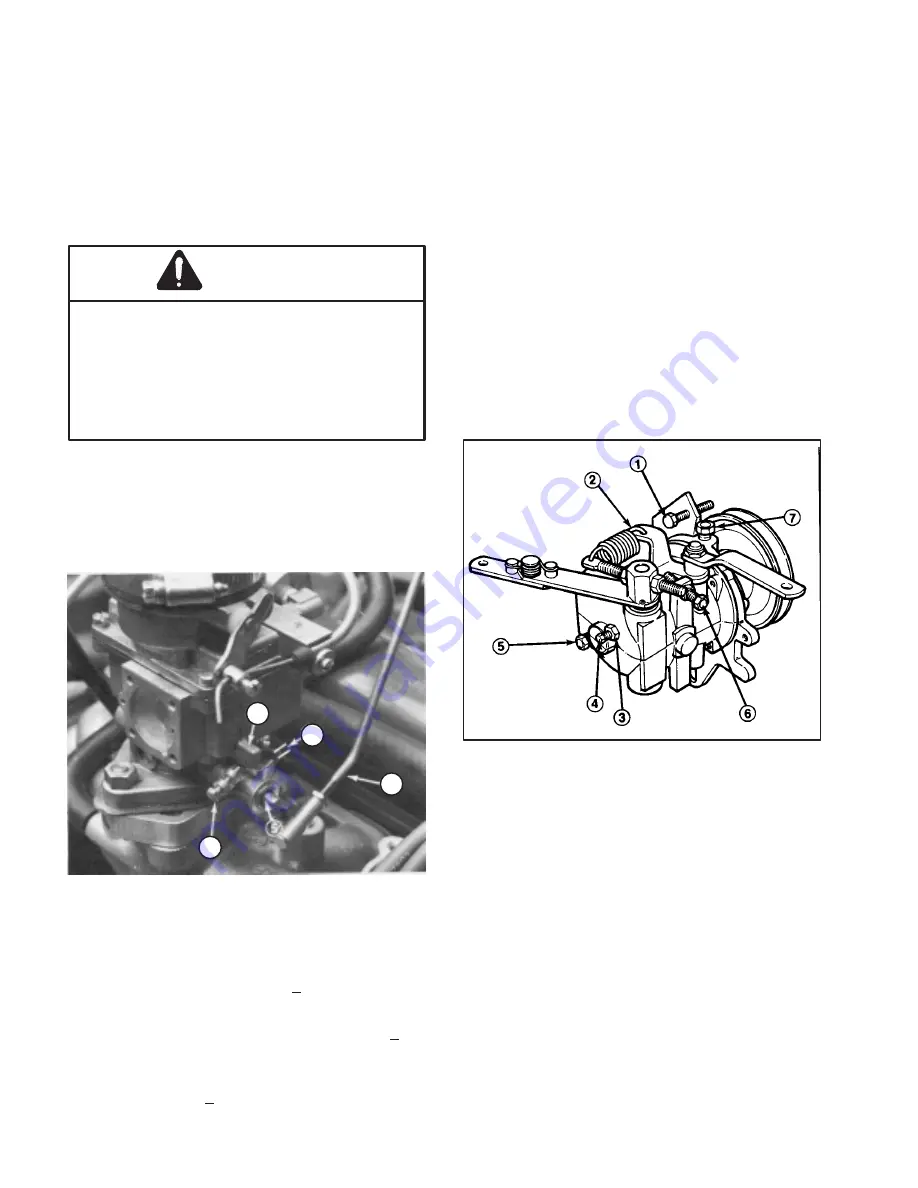
28
ENGINE MAINTENANCE
ADJUSTING GOVERNOR
1.
With engine shut off, move throttle control to FAST
position and open hood. Check between the throttle arm
and the stop on the carburetor base to make sure there
is 1/32” (0.8 mm) gap (Fig. 36). If gap is not correct,
adjust throttle rod (Fig. 36) by turning ball joint ends until
gap is 1/32” (0.8 mm). If gap is correct, proceed to
step 2.
Engine must be running so final adjust-
ment of the governor can be performed.
To guard against possible personal
injury, engage parking brake and keep
hands, feet, face and other parts of the
body away from fan or other moving
parts.
WARNING
2.
Start engine and move throttle to SLOW position.
Allow engine to warm up to normal operating
temperature.
3.
Rotate throttle arm closed until it contacts stop
(Fig. 36).
Figure 36
1. 1/32” (0.8 mm)
2. Throttle rod
3. Carburetor idle speed screw
4. Stop
5. Throttle arm
1
2
3
4
4.
Check idle speed and adjust carburetor idle speed
screw if necessary to attain 1350 + 50 rpm.
5.
Release throttle arm, loosen jam nut on governor
low idle speed screw and adjust it to attain 1500 + 100
rpm (Fig. 36).
6.
Slowly move throttle to FAST position until engine
speed reaches 3200 + 100 rpm. Shut off engine. Adjust
high idle stop screw until it contacts speed control lever
(Fig. 37).
IMPORTANT: Do not over speed the engine
because the transmission could be damaged.
7.
Move throttle rapidly from SLOW to FAST. The
engine should not surge. if engine surges, proceed to
step 8.
8.
Check V–belts from engine to governor pulley and
assure they are tight. If belts are loose, the engine will
surge. If belts are tensioned properly, loosen jam nut
that retains the anti–surge screw (Fig. 37). Rotate screw
clockwise 1/8 turn at a time until surging stops. Should
governor continue to surge, check the following:
A. Carburetor too rich or too lean.
B. Binding in throttle linkage.
C. Governor worn internally.
Figure 37
1. High idle stop screw
2. Speed control lever
3. Jam nut
4. Anti–surge screw
5. Oil check plug
6. low idle stop screw
IMPORTANT: Never rotate anti–surge screw in too
far so that speed of engine increases.
9.
Bump the throttle lever with your hand so engine
speeds up momentarily. If governor is working properly,
engine speed should return to normal within one or two
surges of the governor. More than two surges of the
governor usually indicates than the anti–surge screw
must be turned in slightly more than it is. When
adjustment is correct, lock jam nut against governor
body.
10. Check low and high idle speed to be sure there is no
change from the initial setting. If high idle sped has
increased, anti–surge has been turned into the
governor too far and it must be backed out. Then repeat
the entire adjustment procedure.
Summary of Contents for 30789
Page 2: ......
Page 37: ...36 HYDRAULIC SCHEMATIC...



























